MonsterUp Adventures Review: Building a bigger jumping game

Adapting console-oriented genres like platformers to mobile phones is no easy task due to the average phone’s lack of physical d-pad and buttons. Doodle Jump achieved great success from a combination of intuitive tilt controls and stripping down the platforming game to its bare essentials. Practically anyone could play it for a few minutes and come away satisfied, regardless of their gaming skills. Karios Games’ MonsterUp built on the Doodle Jump formula, adding multiple characters with unique special moves to the mix, but otherwise hewed closely to Lima Sky’s original game.
Did you ever wonder what this offshoot genre (often called jumping games rather than platformers) would be like if some of the traditional platforming elements like structured levels and bosses were put back in? The second MonsterUp title, MonsterUp Adventures, answers that question. It certainly provides more unique content than regular jumping games, but the combination of jumper and platformer doesn’t always gel as well as I’d have hoped.
The story so far
Unlike its predecessor, Adventures actually has a bit of a story in the form of an intro and ending. The textless introduction shows the kindly monsters from the first game approaching an island by hot air balloon. A villainous monster attacks the island and the monsters’ balloon, sending it crashing down. Not a bad setup, but it could use some sound effects, and the music doesn’t fit the scene at all.
Adventure Island
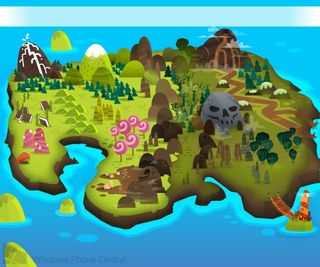
After starting a game, players are greeted by a large and colorful map screen. Initially you have access to only a single level and the ship, but completing each level unlocks the next one. Adventures consists of 16 regular levels and four boss battles. These can all be replayed later.
In the last game, the only goal was to seek high scores by jumping as high as possible in an endless level. Now, each level has a definite end. The top of a level takes about five minutes of skillful jumping to reach; a meter at the right side of the screen shows the player’s progress.
Get the Windows Central Newsletter
All the latest news, reviews, and guides for Windows and Xbox diehards.
Gem collector
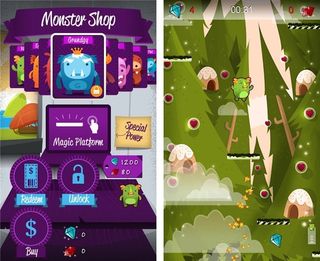
Before you reach the end of the level, you’ll also have to collect a certain number of blue and red gems if you want to pass it and move on to the next one. Blue gems (diamonds) are far more common than the red kind (rubies), so missing a red one can mean failing the level. Because your character always jumps, and you’ll often be propelled quite far and fast by spring platforms, it’s certainly possible to inadvertently pass up a gem.
Some of the unlockable monsters have abilities that make gem collecting easier, such as slowing down the action or magnetically pulling at items. Speaking of unlocking stuff, gems also act as the game’s currency. The shop’s prices are steep, so you’ll either need to play a lot or purchase gems from Karios’ website if you want to unlock everything. In addition to several playable monsters, the shop also sells the game’s single musical theme as a ringtone.
One life to live
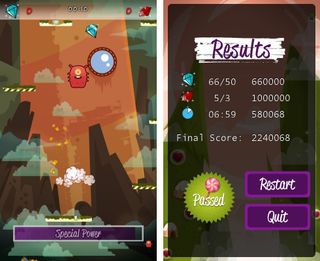
Blue gems serve another purpose besides currency; they can also prevent your monster from dying. Normally, falling off-screen or hitting a spiked platform kills the monster and ends the level – no extra lives here. But if you have enough diamonds, you’ll just lose a bunch of them and bounce away from harm.
Several problems arise from this system. One, dropping a bunch of blue gems and surviving can cause you to reach the end of the level without the amount required to pass it. Getting to the end of a level only to fail is extremely frustrating. But so is dying because you didn’t have enough diamonds in the first place. I’d much rather having a single extra life to count on, leaving the gems out of the respawning equation.
The main issue with the gems though is that you only get to keep them if you beat the level. Fall off-screen or land on spikes (quite likely in the later levels) and you won’t keep the currency you collected. It takes forever to unlock anything from the store because of this. The overall challenge was reduced in the latest patch, but the later levels can still get frustrating. If players made progress towards unlocking things even when dying, the game would be much more addictive and less frustrating. As it stands, I don’t feel like replaying levels because I’m not likely to profit from most of my attempts.
Spin that wheel
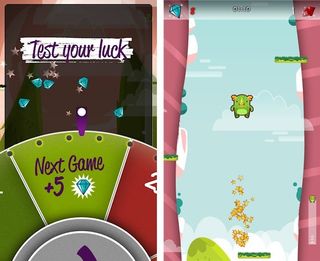
On the happier side, collecting bonus tokens during a level allows you to spin the bonus wheel whether you complete or fail the stage. The wheel pays out gems that either contribute towards the next level’s requirements or simply get added to the player’s bank. The bonus wheel does little to alleviate the disappointment of not keeping your gems upon death, but it’s fun regardless.
Boss blues
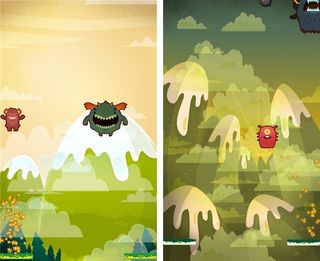
Possibly for the first time in a jumping game, Adventures features boss battles. Unfortunately their implementation leaves much to be desired. Depending on the boss, the goal is basically to jump on the boss’s head or deflect projectiles at it. However, players have precious little control over their character’s movement, making dodging unpleasant, and falling off the screen still results in death. Worse, you can’t even jump off-screen horizontally and come out of the other side, unlike normal levels. At least the developer plans to fix that last complaint in a future update.
Still, these boss battles just don’t work with this style of game. A better implementation would be races through a level against a boss – that’d match the general gameplay better without sacrificing fun factor.
Graphics and sound
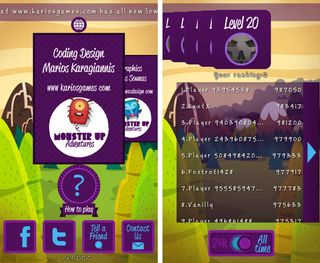
Left: Poor vertical symmetry at work.
Adventures once again features fantastic and colorful 2D art from Ilias Sounas. Users can enable 3D platforms in the Options, but I strongly recommend turning them off as they make the game even harder. More importantly, the UI elements are generally spaced poorly on the screen with no regard for vertical symmetry. In the future, it would be a good idea to have the game’s artist or someone else with good visual design sense look over the menus prior to publishing.
Adventures’ sound design needs improvement too. First, a game of this scope needs more than one song to its name. The lack of unique music most obviously diminishes the intro and boss fights. Plus I find the game’s one tune quite grating. The first game’s solitary song sounded so much better. Sound effect-wise, the gem collection sounds would be appropriate in a game with retro-styled visuals, but they don’t quite match this game’s style. Again, having an artist on the actual development team would probably help.
Overall Impression
I admire MonsterUp Adventures for its ambition compared to other jumping games. But as someone who plays a lot of professionally-made games (and some standout indie titles), the rough edges sometimes pulled me out of the experience. The gem system needs an overhaul, and the bosses are just so poorly done that the game would be better off without them. That said, the developer has already improved Adventures dramatically since its initial release. A little more tweaking could really boost this installment’s staying power.
MonsterUp Adventures costs $1.99 and works great with WP7 and WP8. Get it here on the Windows Phone Store.

Paul Acevedo is the Games Editor at Windows Central. A lifelong gamer, he has written about videogames for over 15 years and reviewed over 350 games for our site. Follow him on Twitter @PaulRAcevedo. Don’t hate. Appreciate!

